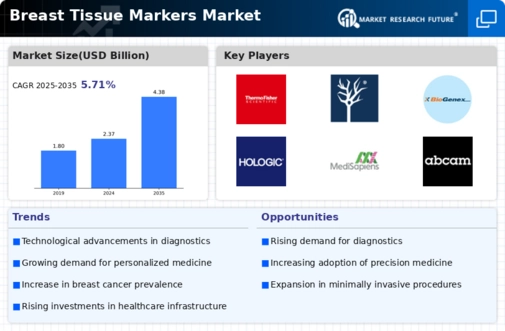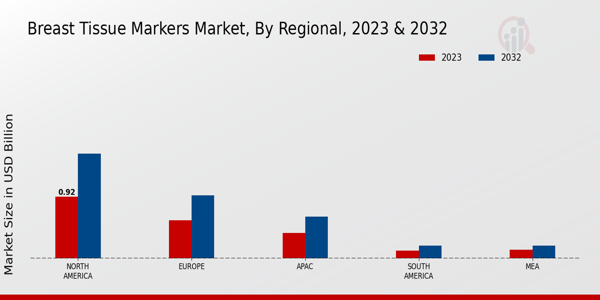Market Growth Projections
The Global Breast Tissue Markers Market Industry is projected to experience substantial growth over the next decade. With an estimated market value of 2.37 USD Billion in 2024, the industry is expected to expand significantly, reaching approximately 4.38 USD Billion by 2035. This growth trajectory suggests a compound annual growth rate of 5.73% from 2025 to 2035. The increasing demand for accurate diagnostic tools, driven by factors such as rising breast cancer incidence and technological advancements, underpins these projections. As healthcare systems worldwide continue to prioritize early detection and personalized treatment, the market for breast tissue markers is likely to flourish.
Regulatory Support and Guidelines
Regulatory support and established guidelines for breast cancer diagnostics are crucial factors driving the Global Breast Tissue Markers Market Industry. Government health agencies and organizations are increasingly endorsing the use of breast tissue markers as part of standard diagnostic protocols. This endorsement not only legitimizes the use of these markers but also encourages healthcare providers to adopt them in clinical settings. As regulatory bodies continue to emphasize the importance of accurate diagnostics in breast cancer management, the market is likely to expand. The anticipated growth trajectory suggests that the market could reach 4.38 USD Billion by 2035, bolstered by supportive regulatory frameworks.
Rising Incidence of Breast Cancer
The increasing incidence of breast cancer globally is a primary driver for the Global Breast Tissue Markers Market Industry. According to health statistics, breast cancer remains one of the most prevalent cancers among women, with millions diagnosed annually. This rising trend necessitates advanced diagnostic tools, including breast tissue markers, which aid in early detection and personalized treatment plans. As the global population ages and awareness of breast health increases, the demand for these markers is expected to grow. This growth is reflected in market projections, estimating the Global Breast Tissue Markers Market to reach 2.37 USD Billion in 2024.
Growing Awareness and Screening Programs
The global increase in awareness regarding breast cancer and the importance of early detection is a significant driver for the Global Breast Tissue Markers Market Industry. Public health initiatives and screening programs have been implemented in various countries, encouraging women to undergo regular check-ups and screenings. This heightened awareness leads to an increase in the utilization of breast tissue markers, as healthcare providers seek to enhance diagnostic accuracy. Consequently, the market is expected to experience a compound annual growth rate of 5.73% from 2025 to 2035, reflecting the positive impact of these awareness campaigns on the demand for breast tissue markers.
Technological Advancements in Diagnostic Tools
Technological innovations in diagnostic tools are significantly influencing the Global Breast Tissue Markers Market Industry. The development of more precise and efficient markers enhances the accuracy of breast cancer diagnostics, leading to better patient outcomes. Innovations such as digital pathology and molecular imaging are becoming increasingly integrated into clinical practice, allowing for more detailed analysis of tissue samples. These advancements not only improve the reliability of test results but also facilitate quicker turnaround times for patients. As a result, the market is poised for growth, with projections indicating a rise to 4.38 USD Billion by 2035, driven by these technological enhancements.
Increasing Investment in Healthcare Infrastructure
The expansion of healthcare infrastructure, particularly in developing regions, is a vital driver for the Global Breast Tissue Markers Market Industry. As countries invest in improving their healthcare systems, access to advanced diagnostic tools, including breast tissue markers, becomes more widespread. This investment is essential for enhancing the quality of care and ensuring that patients receive timely and accurate diagnoses. Furthermore, as healthcare facilities upgrade their technologies, the demand for innovative diagnostic solutions is likely to rise. This trend is expected to contribute to the market's growth, with projections indicating a steady increase in revenue over the coming years.



















